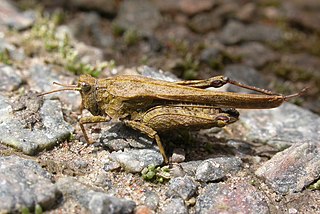
Tetrigidae is an ancient family in the order Orthoptera, which also includes similar families such as crickets, grasshoppers, and their allies. Species within the Tetrigidae are variously called groundhoppers, pygmy grasshoppers, pygmy devils or "grouse locusts".

Tettigidea is a genus of groundhoppers or pygmy grasshoppers in the tribe Batrachideini from the Americas. There are at least 40 described species in Tettigidea.

Tetrix is a genus of ground-hoppers or pygmy grasshoppers in the family Tetrigidae. There are at least 180 described species in Tetrix.

Tettigidea armata is a species in the family Tetrigidae, in the order Orthoptera. The species is known generally as the "armored pygmy grasshopper", "armoured grouse locust", or "spined grouse locust". It is found in North America.
Morsea islandica, the island monkey grasshopper, is a species of monkey grasshopper in the family Eumastacidae. It is found in North America.

Gryllidea is an infraorder that includes crickets and similar insects in the order Orthoptera. There are two superfamilies, and more than 6,000 described species in Gryllidea.

Melanoplini is a tribe of spur-throated grasshoppers in the family Acrididae. There are about 19 genera and more than 200 described species in Melanoplini, all in North America. Their biogeography shows that many species in the tribe have descendants from the Eocene epoch and Miocene epoch.
Tettigidea acuta, the acute pygmy grasshopper, is a species of pygmy grasshopper in the family Tetrigidae. It is found in North America.
Morsea is a genus of monkey grasshoppers in the family Eumastacidae. There are about seven described species in Morsea.

Xanthippus is a genus of band-winged grasshoppers in the family Acrididae. There are about six described species in Xanthippus.
Paratylotropidia is a genus of spur-throated grasshoppers in the family Acrididae. There are at least three described species in Paratylotropidia.

Tetrix arenosa, known generally as the obscure pygmy grasshopper or obscure grouse locust, is a species of pygmy grasshopper in the family Tetrigidae. It is found in North America.
Xeracris minimus, the least desert grasshopper, is a species of slant-faced grasshopper in the family Acrididae. It is found in Central America and North America.
Dichopetala catinata, the spoon-tailed short-wing katydid, is a species of phaneropterine katydid in the family Tettigoniidae. It is found in North America.

Melanoplus frigidus, known generally as the Nordic mountain grasshopper or narrow-winged locust, is a species of spur-throated grasshopper in the family Acrididae. It is found in Europe and Northern Asia.
Paratylotropidia brunneri is a species of spur-throated grasshopper in the family Acrididae. It is found in North America.
Neduba propsti, known generally as the Catalina shield-back cricket or Propst's shieldback, is a species of shield-backed katydid in the family Tettigoniidae. It is found in North America.
Tetrix ornata, known generally as the ornate pygmy grasshopper or ornate grouse locust, is a species of pygmy grasshopper in the family Tetrigidae. It is native to North America.

Scaria is a genus of groundhoppers or pygmy grasshoppers in the tribe Batrachideini from South America. There are about eight described species in Scaria.








